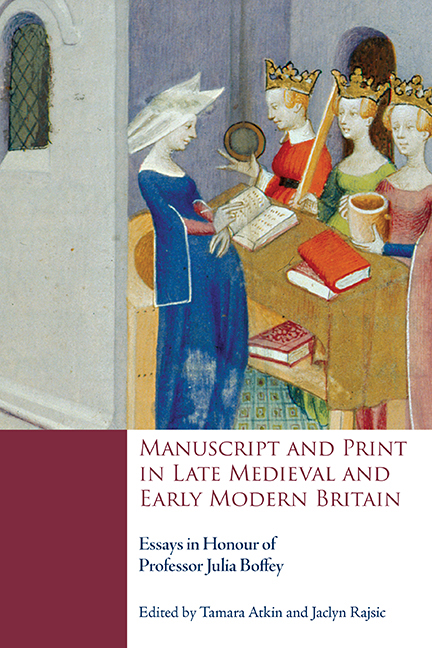 Manuscript and Print in Late Medieval and Early Modern Britain
Manuscript and Print in Late Medieval and Early Modern Britain Book contents
- Frontmatter
- Contents
- List of Illustrations
- List of Contributors
- Acknowledgements
- List of Abbreviations
- Introduction
- PRODUCING TEXTS
- 1 Gower's ‘Epistle to Archbishop Arundel’: The Evidence of Oxford, All Souls College, MS 98
- 2 From Oxford to Eton with Master John Maunshull: Teaching the Tria sunt in Bodleian Library MS Laud misc. 707
- 3 Gavin Douglas, Aesthetic Organization and Individual Distraction
- 4 Gavin Douglas's Eneados: The 1553 Edition and its Early Owners and Readers
- 5 Caxton and the Crown: The Evidence from the Exchequer of Receipt Reconsidered
- 6 Late Medieval Books of Hours and Their Early Tudor Readers In and Around London
- 7 London, British Library, MS Harley 367 and the Antiquarian Ideals of John Stow
- READING INFLUENCE
- Afterword
- Julia Boffey: A Bibliography
- Manuscript Index
- General Index
- Tabula Gratulatoria
3 - Gavin Douglas, Aesthetic Organization and Individual Distraction
from PRODUCING TEXTS
Published online by Cambridge University Press: 06 September 2019
- Frontmatter
- Contents
- List of Illustrations
- List of Contributors
- Acknowledgements
- List of Abbreviations
- Introduction
- PRODUCING TEXTS
- 1 Gower's ‘Epistle to Archbishop Arundel’: The Evidence of Oxford, All Souls College, MS 98
- 2 From Oxford to Eton with Master John Maunshull: Teaching the Tria sunt in Bodleian Library MS Laud misc. 707
- 3 Gavin Douglas, Aesthetic Organization and Individual Distraction
- 4 Gavin Douglas's Eneados: The 1553 Edition and its Early Owners and Readers
- 5 Caxton and the Crown: The Evidence from the Exchequer of Receipt Reconsidered
- 6 Late Medieval Books of Hours and Their Early Tudor Readers In and Around London
- 7 London, British Library, MS Harley 367 and the Antiquarian Ideals of John Stow
- READING INFLUENCE
- Afterword
- Julia Boffey: A Bibliography
- Manuscript Index
- General Index
- Tabula Gratulatoria
Summary
A VIAL OF CHRIST'S BLOOD, the Holy Blood, is kept in the cathedral in Bruges. It is the focus of an annual procession each Ascension Day which brings together the local aristocracy, civic guilds and ecclesiastical community. The first reliable record of the Holy Blood's material presence in Bruges dates from 1250. The Bruges Confraternity of the Holy Blood was formed in 1400 and has continuous records dating back to 1441. The President of the current Confraternity expresses the view that ‘we don't know the DNA of the Holy blood, but the DNA of the Holy blood is in all the citizens of Bruges’. The relic is a part of local identity, and the procession links relic, historical town and present-day citizens by creating communality on the streets, but also by representing the history of the community in the final part of the procession, after the biblical narrative. The annual sequence of processions was interrupted during the period of the Calvinist Republic, the French Revolution and both World Wars, but has proved remarkably tenacious despite dissent from the secular left.
The so-called ‘Fetternear Banner’, preserved in the National Museum of Scotland (see Figure 3.1), is a remarkable survivor connected with another confraternity and procession dedicated to the Holy Blood which was suppressed by Calvinist reformers, never to be revived. This Confraternity of the Holy Blood, founded sometime in the fifteenth century, was based in St Giles Cathedral in Edinburgh. In the following pages, I shall link the persistent iconographic schemae associated with devotion to the Holy Blood, their didactic and meditative organization, with the impulse to devotional discipline which presents itself as a preoccupation in the point of view of one of the Fetternear banner's apparent patrons.
The Fetternear banner has three coats of arms on it, and space for a fourth. One of these is that of one who was both aristocratic and in holy orders, the poet Gavin Douglas. The arms are surmounted by a mitre, dating the banner to the period 1515–22 when Douglas was bishop of Dunkeld, but he also held the Provostship of St Giles from 1503 to 1521, a period when he was reputedly more in Edinburgh than in his bishopric.
- Type
- Chapter
- Information
- Manuscript and Print in Late Medieval and Early Modern BritainEssays in Honour of Professor Julia Boffey, pp. 53 - 72Publisher: Boydell & BrewerPrint publication year: 2019


